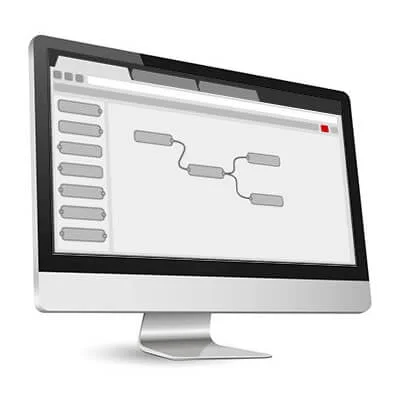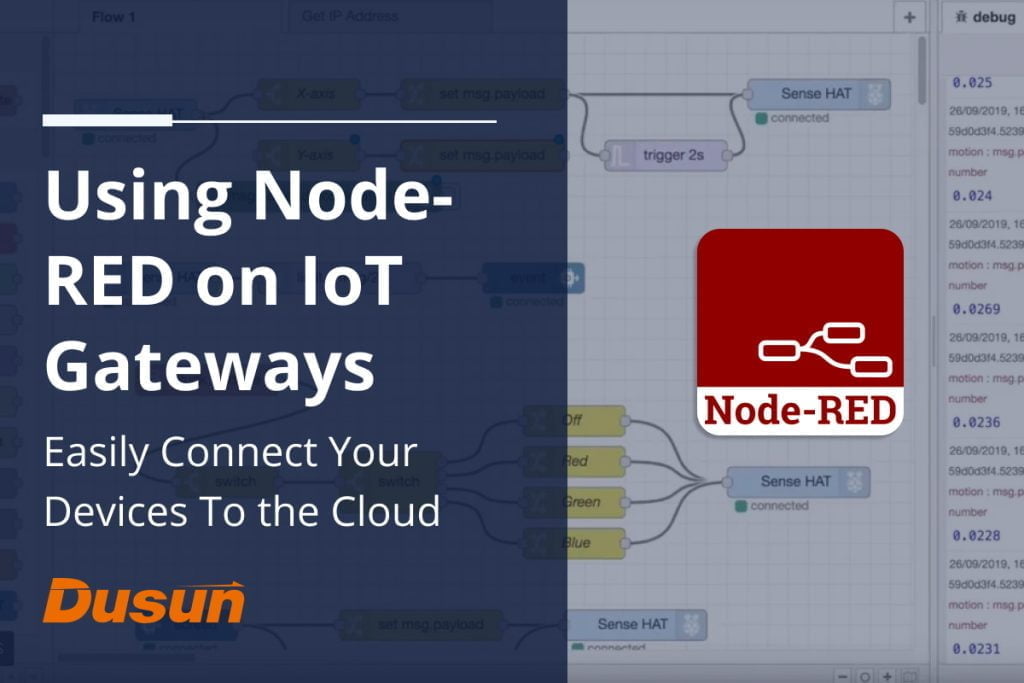Node-RED is an excellent tool for IoT gateway development, allowing developers to create sophisticated IoT applications in a user-friendly environment. Its visual interface and extensive library of nodes and integrations make it easy to develop, test, and deploy IoT applications in a fraction of the time it would take to code manually.
What Is Node-RED?
Node-RED is a popular flow-based programming tool widely used in developing Internet of Things (IoT) applications. It is an open-source software tool that provides a graphical user interface for wiring various devices, APIs, and services to create IoT applications. Node-RED is often used in IoT Gateway, some may call it node red gateway, an IoT gateway development tool that allows developers to easily connect and manage data flows between IoT devices, cloud services, and other applications. With Node-RED IoT, developers can create complex IoT workflows and automation rules without needing advanced programming knowledge.
Benefits of Using Node-RED on IoT Gateways
Easily Connect to Cloud Platform
Node-RED support HTTP, MQTT, WebSocket, TCP, UTP protocols, which creates great convenience for devices and cloud server communication. With this feature, users can easily connect their virtual assistant devices via cloud platforms like AWS, to realize voice control.
Easy-to-use Programming Environment and Scalability
Node-RED offers a web-based visual programming environment by dragging and dropping defined nodes into the workspace, and then creating data streams. There are nearly 225,000 modules in Node’s package repository, so you can add new features whatever you like.
Open Sourceness and Easy to Share
Node-RED is maturely developed, and enjoys rich ecosystem resources. There are many people using Node-RED in the world, users can experience and talk with each other. Flows in Node-RED can be easily exported for sharing with others.
How Does Node-RED Work in IoT Gateway Development?
There are several approaches to IoT Gateway implementation. For instance, you can easily build an IoT gateway with Node-RED, open-source software, and a Raspberry Pi. The work of the Raspberry Pi is to provide the necessary computer and Node-RED with a software interface to address the protocols of the actuators and sensors in the field and to set up communication.
Explore: Is Raspberry Pi An IoT Device?
Node-RED, the innovative low-cost platform, was created to realize IoT apps, cloud integration, and local processing without programming knowledge. The emergence of Node-RED made it simple to connect old and new technologies in terms of the Internet of things (IoT). Node-RED provides a browser-based flow editor that connects flows using a range of network nodes available in the palette.
There’s always one input or output within a node. Messages are then exchanged between the nodes, which can be processed in multiple ways. For instance, the measurement data of a regular temperature sensor can be formatted into the required data format and then transmitted to a cloud architecture through MQTT. Check out the image below illustrating a schematic overview. On the left-hand side, we have the nodes dragged and dropped into the center field and connected based on the logic.
Is Node-Red An MQTT Broker?
Node-RED is not an MQTT broker, although it does have built-in support for the MQTT protocol. MQTT (Message Queuing Telemetry Transport) is a lightweight messaging protocol commonly used in IoT applications. It is designed for low-bandwidth and high-latency networks, making it ideal for IoT devices with limited processing power and connectivity. MQTT brokers receive and forward messages between IoT devices and applications. While Node-RED can interact with MQTT brokers and subscribe to or publish messages, it is not an MQTT broker..
Explore: MQTT gateway
Functions of Node-RED in IoT Gateway Development
Here are some of the use cases of Node-RED in IoT gateway development:
Data Integration
Node-RED can integrate data from various sources, such as sensors, devices, and cloud services. It can extract, transform, and load data from different sources into a common format, making it easier to process and analyze the data.
Device Management
Node-RED can be used to manage IoT devices connected to the IoT gateway. It can monitor device status, configure device settings, and update device firmware.
Edge Analytics
Node-RED can perform edge analytics on the data collected by IoT devices. It can be used to apply machine learning algorithms to the data to identify patterns, detect anomalies, and make predictions.
Explore:IoT Edge Gateway
Dashboard Creation
Node-RED can be used to create dashboards for monitoring and controlling IoT devices. It can create real-time visualizations of sensor data and provide an interface for controlling the devices.
Cloud Integration
Node-RED can integrate IoT gateway data with cloud services such as AWS, Azure, and Google Cloud. It can be used to send data to the cloud, receive data from it, and trigger cloud functions based on events.
Explore: AWS IoT gateway
Node-RED vs. Other IoT Gateway Applications
Let’s now compare Node-RED to other IoT gateway development tools.
Node-RED Vs. OpenHAB
Node-RED uses a visual programming model that allows users to create flows using drag-and-drop nodes. This makes it easy to create complex automation flows without requiring extensive programming experience. OpenHAB, on the other hand, uses a text-based configuration model that requires more programming knowledge.
Explore: OpenHAB Gateway
Node-RED Vs. Jeedom
Node-RED is more flexible than Jeedom regarding the range of devices and services it can support. Node-RED has an extensive library of nodes that can support a broad range of devices and services, while Jeedom has a wide range of plugins and modules.
Explore: Jeedom Gateway
Node-RED Vs. Thingsboard
Thingsboard is an open-source IoT platform that can build IoT gateways and manage IoT devices. Thingsboard provides a device management system, data collection, and real-time visualization. Thingsboard uses a rule engine for data processing and provides a web-based user interface for dashboarding. On the other hand, Node-RED uses a visual programming model and relies on third-party dashboard tools to provide a user interface.
Explore: ThingsBoard Gateway
Node-RED Vs. Home Assistant
The Home Assistant has more integrations than Node-RED. And the majority of these integrations operate ” out of the box” and don’t require any special installation. You’ll need to install several boxes to activate all the integrations when using Node-RED. Still, it may need to be on par with the range of components supported by Home Assistant.
Explore: Home Assistant Gateway
You can create complex or simple automation using YAML or the web-based editor. Although the configuration of automation isn’t visual like it is with Node-RED, the entire process gets friendlier with every update.
Logic operators like AND/OR, IF/THEN/ELSE, etc., are configurable using Node-RED. Using the Node-RED visual editor, you can also create highly complex and smart automation with plenty of details. Node-RED makes this process easy, whereas home assistant automation would find it challenging.
Dusun IoT Gateway Using Node-RED Recommendation
Our DSGW-210 IoT Edge gateway using Node-RED comprises several protocol support and edge computing capabilities. On this device, the Node-RED is installable, and it provides a visual browser-focused drag-and-drop Node-RED stream editor that lets you effortlessly connect hardware devices to several IoT services.

The idea for developing our Node-RED IoT gateway stems from the DSGW-210 IoT Edge Gateway.
To properly utilize remote control and updates, the Node-Red Gateway plugs into an Ethernet port of your ADSL box or router. But it is also loaded with Wi-Fi technology, which enables it to be placed in any location of your choice at home.
In addition, Node Red Gateway is also equipped with Bluetooth 5.2 technology, making it directly functional with Node-RED compatible devices for Bluetooth connection.
Explore: Bluetooth Gateway
Conclusion
Regarding navigating the web, the mobile has surpassed the personal computer as the leading device since early 2014. It’s not just the mobile; even several other portable devices that connect to the web are advancing at an exponential rate.
Many of us are owners of one or more Internet-based devices and mobile devices. In essence, the Internet of things (IoT) presently isn’t just limited to different “things” but has advanced into “intelligent things” which possess Onboard computations and network connections. Particularly, they are capable of sensing the environment around us and, accordingly, acting intelligently.
This technological adaptation has resulted in several developments in the visual programming and visual coding arenas. Consequently, it has advanced into a visual programming/coding tool based on the existing popular Node.js, majorly after the IoT space.



















